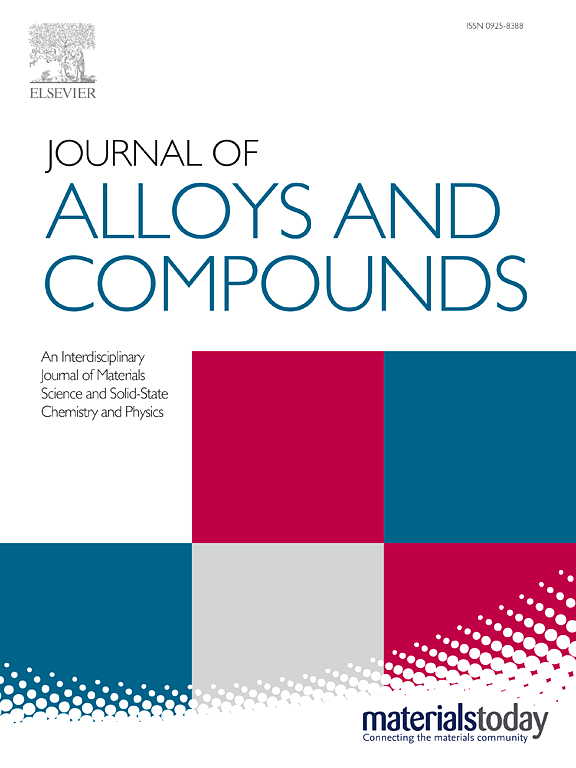基于多变量优化方法的基于氧化石墨烯的PbTiO3/CoFe2O4的新型合成增强高效储能的潜在材料
IF 5.8
2区 材料科学
Q2 CHEMISTRY, PHYSICAL
引用次数: 0
摘要
氢储存是发展燃料电池和氢技术的关键,用于运输、便携式电源和固定电源。可再生能源汽车需要储氢化合物。为此,通过简单的方法,设计了氧化石墨烯(GO)上的PbTiO3/CoFe2O4作为电化学储氢应用的电极材料。在碱性环境下,采用时间电位法对样品的储氢性能进行了表征。首先,采用旋转中心复合方法对三个实际因素进行了试验设计。采用新工艺合成纳米复合材料后,采用时间电位法对设计的17个实验进行充放电,并利用响应面法进行优化。经过12次循环后,PbTiO3/CoFe2O4/GO纳米复合材料的放电容量为2859.5 mAhg-1。循环伏安法测定了PbTiO3/CoFe2O4/GO纳米复合材料的原始电化学性能,其中阳极和阴极峰值电流分别约为0.0116和-0.006 A。采用x射线衍射(XRD)、扫描电镜(SEM)、能量色散x射线能谱(EDX)、元素作图和N2吸附-解吸技术对产物进行了表征。结果表明,基于scherrer方程和BJH孔径分布图,PbTiO3/CoFe2O4/GO纳米复合材料的平均晶粒尺寸为25.3 nm,平均孔径为2.17 nm。电化学阻抗谱(EIS)结果表明,PbTiO3/CoFe2O4/GO样品的极化电阻为176 Ω。本文章由计算机程序翻译,如有差异,请以英文原文为准。

Novel synthesis of PbTiO3/CoFe2O4 based on graphene oxide as potential materials for enhancing efficient energy storage using multivariate optimization method
Hydrogen storage is key to developing fuel cells and hydrogen technologies for use in transportation, portable power, and stationary power. Hydrogen storage compounds are needed for renewable energy vehicles. With this aim, PbTiO3/CoFe2O4 on graphene oxide (GO) was designed as materials of electrode for applications of electrochemical hydrogen storage through a straightforward approach. The hydrogen storage performance of the samples was characterized based on the chronopotentiometry technique in an alkaline environment. First, the experimental design was carried out using the rotating central composite method for three practical factors. After synthesizing the nanocomposite using the new process, charging and discharging were carried out using the chronopotentiometry method for 17 designed experiments, and then optimization was done using the response surface method. The discharge capacity of the PbTiO3/CoFe2O4/GO nanocomposite was evaluated to be 2859.5 mAhg-1 after 12 cycles. Cyclic voltammetry was then used to determine the pristine electrochemical properties of the PbTiO3/CoFe2O4/GO nanocomposite, where the anodic and cathodic peak currents were about 0.0116 and -0.006 A, respectively. The products were characterized using X-ray diffraction (XRD), scanning electron microscopy (SEM), energy dispersive X-ray (EDX) spectroscopy, elemental mapping and N2 adsorption-desorption techniques. The results indicate the average crystallite size of 25.3 nm and average pore diameter of 2.17 nm in the case of PbTiO3/CoFe2O4/GO nanocomposite based on the scherrer equation and BJH pore size distribution plot, respectively. Furthermore, electrochemical impedance spectroscopy (EIS) results showed that the polarization resistance of the PbTiO3/CoFe2O4/GO sample is 176 Ω.
求助全文
通过发布文献求助,成功后即可免费获取论文全文。
去求助
来源期刊

Journal of Alloys and Compounds
工程技术-材料科学:综合
CiteScore
11.10
自引率
14.50%
发文量
5146
审稿时长
67 days
期刊介绍:
The Journal of Alloys and Compounds is intended to serve as an international medium for the publication of work on solid materials comprising compounds as well as alloys. Its great strength lies in the diversity of discipline which it encompasses, drawing together results from materials science, solid-state chemistry and physics.
 求助内容:
求助内容: 应助结果提醒方式:
应助结果提醒方式:


